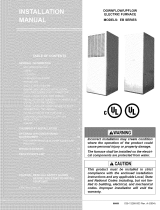
3
IMPORTANT SAFETY INFORMATION
INSTALLER: Please read all instructions before servicing
this equipment. Pay attention to all safety warnings and
any other special notes highlighted in the manual. Safety
markings are used frequently throughout this manual to
designate a degree or level of seriousness and should not
be ignored. WARNING indicates a potentially hazardous
situation that if not avoided, could result in personal injury
or death. CAUTION indicates a potentially hazardous
situation that if not avoided, may result in minor or moderate
injury or property damage.
This appliance is not intended for use by persons
(including children) with reduced physical, sensory or
mental capabilities, or lack of experience and knowledge,
unless they have been given supervision or instruction
concerning use of the appliance by a person responsible
for their safety. Children should be supervised to ensure
that they do not play with the appliance.
REQUIREMENTS & CODES
WARNING:
This unit must be installed in accordance
with instructions outlined in this manual
during the installation, service, and operation
of this unit. Unqualified individuals should
not attempt to interpret these instructions or
install this equipment. Failure to follow safety
recommendations could result in possible
damage to the equipment, serious personal
injury or death.
• The installer must comply with all local codes and
regulations which govern the installation of this type
of equipment. Local codes and regulations take
precedence over any recommendations contained
in these instructions. Consult local building codes
and the National Electrical Code (NEC) for special
installation requirements.
• All electrical wiring must be completed in accordance
with local, state and national codes and regulations
and with the National Electric Code (ANSI/NFPA
70) or in Canada the Canadian Electric Code (CSA
Z240.6.1, & Z240.9.1).
• Design and construction of the home duct system,
must be in accordance with: HUD Manufactured Home
Construction & Safety Standard (Title 24, Part 3280)
and American National Standards (ANSI) A119.11,
C1-NFPA 7.
• Plenums and air ducts must be installed in accordance
with the Standard for the Installation of Air Conditioning
and Ventilating Systems (NFPA No. 90A) or the
Standard for the Installation of Warm Air Heating and
Air Conditioning Systems (NFPA No. 90B).
• Follow all precautions in the literature, on tags, and
on labels provided with the equipment. Read and
thoroughly understand the instructions provided with
the equipment prior to performing the installation and
operational checkout of the equipment.
This unit E7 is a PARTIAL UNIT AIR CONDITIONER,
complying with PARTIAL UNIT requirements of this
International Standard, and must only be connected to
other units that have been confirmed as complying
to corresponding PARTIAL UNIT requirements of this
International Standard, UL 60335-2-40/CSA C22.2 No.
60335-2-40, or UL 1995/CSA C22.2 No 236.
Minimum Installation Clearances
• Access for positioning and servicing the unit must be
considered when locating unit. The need to provide
clearance for access to panels or doors may require
clearance distances over and above the requirements.
For alcove installations allow 24 (61 cm) inches
minimum clearance from the front of the unit for
future servicing. Closet installations require 6
inches (152 mm)minimum.
• This appliance must be installed in accordance with
clearances listed in Table 1. The Appliance must be
installed with ample clearance for easy access to the
air filter, blower assembly, burner assembly, controls,
and vent connections.
Table 1. Minimum Clearance Requirements
* For upflow application using upflow stand, 3” (76 mm) minimum
per side.
** Service Clearance
ALL MODELS CLOSET ALCOVE
Front ** 6" (152 mm) 24" (609 mm)
Back 0" 0"
Sides* 0" 0"
Top 0" 0"
Top & Sides of Duct 0" 0"
Bottom of Duct 0" 0"
• Locate and install this unit in position as specified
on page 5. This unit is designed only for Indoor
installations and should be located with consideration
of minimizing the length of the supply and return ducts.
See Table 4 (page 15), Table 5 (page 16), or the
rating plate for circulating airflow data.
Minimum Unobstructed Airflow
• Sufficient clearance for unobstructed airflow must be
maintained in order to achieve rated performance.
Air return to the Appliance must have the minimum
required total free area:
— 200 in2 (1290 cm2 ) for furnace only. May also
include return air grille and frame assembly P/N
902989 or wall mount grille P/N 902999).
— 235 in2 (1516 cm2 ) with 4 ton or smaller A.C. or
H.P. installed.
— 250 in2. (1613 cm2 ) with 4 ton or smaller A.C. or
H.P. installed & 1” special clearance.
— 275 in2 (1775 cm2 ) with up to 5 ton A.C. or H.P.
installed.
• If using louvered doors, the total free area must be
calculated. Louvered doors installed at the factory are
about 70% free area. If using a third party louvered
door manufacturer, check their technical specifications
to determine the free area.




















